The Surface 3 Review
by Brett Howse on May 4, 2015 9:00 AM ESTGPU Performance
The Surface 3 with the Atom x7-Z8700 pairs the Intel Gen 8 Graphics from Broadwell with the Airmont CPU cores of Atom. Unlike the Broadwell cores though, the Surface 3 SoC only has 16 execution units (EUs) as compared to 24 in Core M. The maximum frequency is also reduced to 600 MHz for these cores, as compared to up to 900 MHz in Core M. This is all necessary to keep the x7-8700 in the 2 watt SDP.
So performance will be a step back compared to Core M, but really this should be no surprise. The interesting comparison will be how it compares to Surface Pro 3 with Haswell Gen 7.5 graphics and of course to Bay Trail equipped tablets.
We will start with some synthetic tests and then move on to DOTA 2 to see how it performs on a real world game.
3DMark Tablet
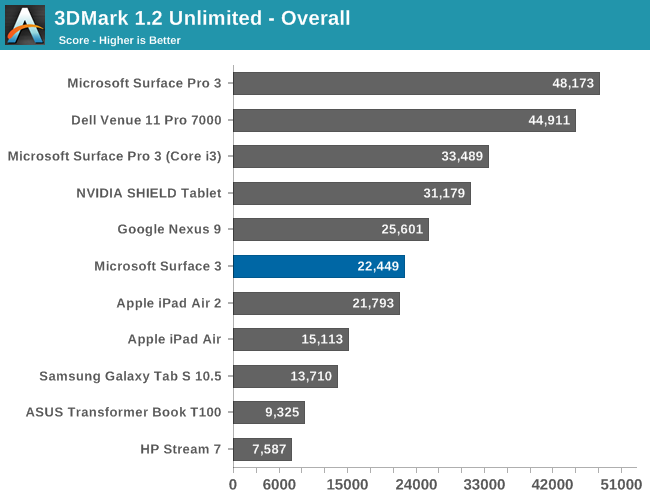


The GPU upgrade is a big improvement over the ASUS T100's Bay Trail graphics, but the Atom GPU still can not compete with the fastest tablet SoCs out there.
3DMark Notebook
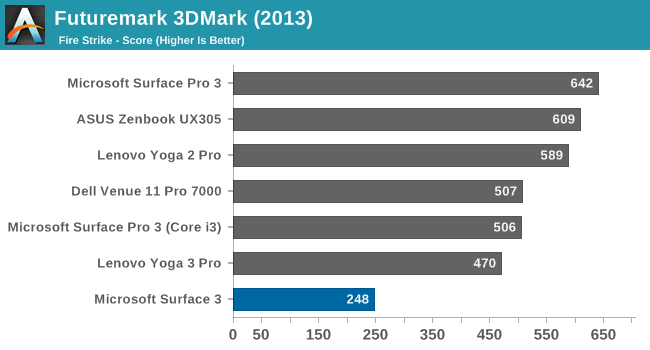
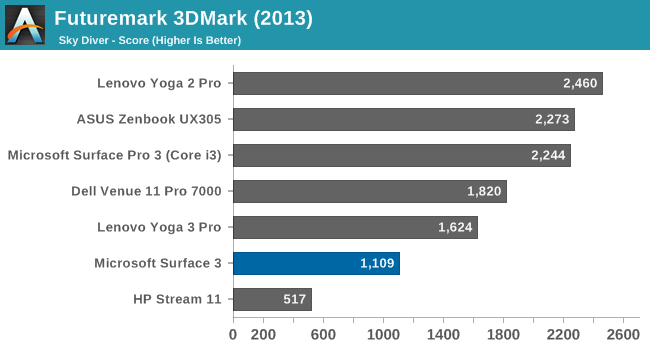
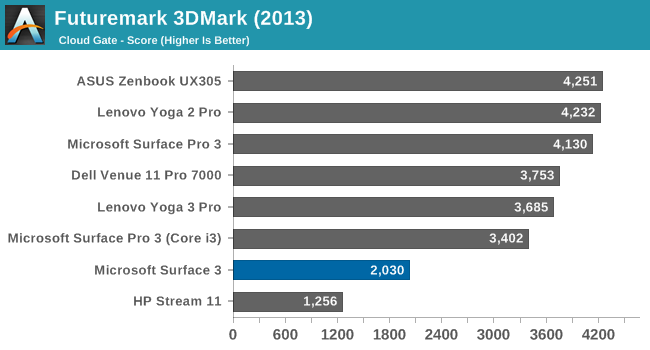

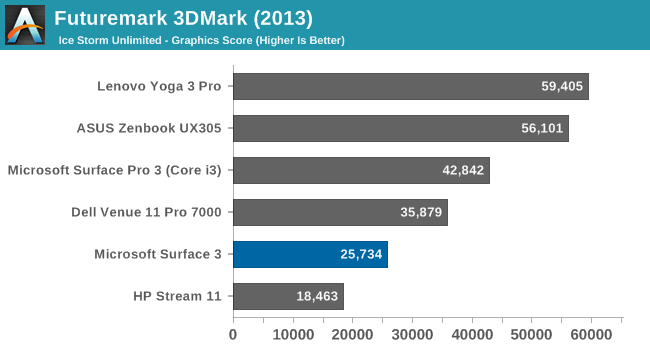
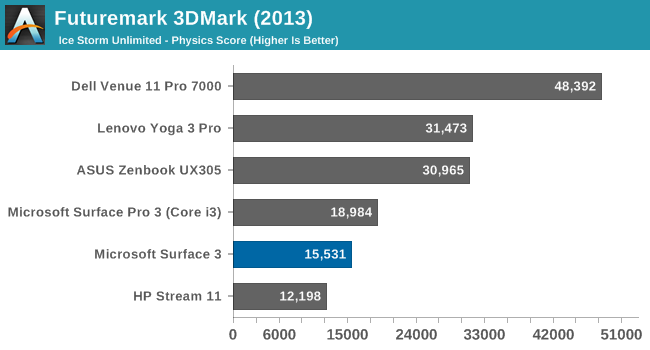
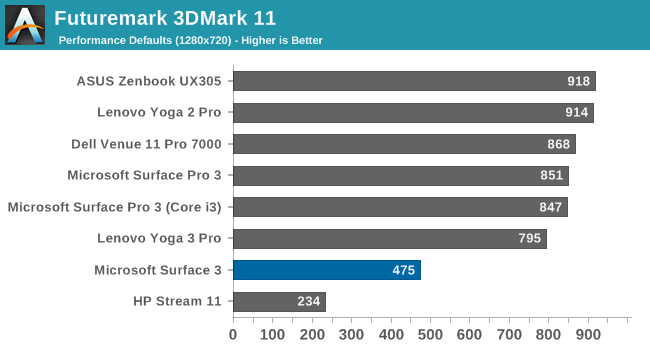
Comparing the Surface 3 to PC class hardware puts it in a pretty poor light when looking at GPU performance. Our 3DMark tests have the Surface Pro 3 with the Core i3 on average 40% faster than Surface 3. Comparing it to the Dell Venue 11 Pro with Core M, we find the Core M GPU is on average 47% faster, which is quite a gap. Let’s not forget though that the Surface 3 is a mere 2 watt SDP, whereas Core M is a 4.5 W TDP and the Haswell-Y in Surface Pro 3 is an 11.5 W TDP.
GFXBench Tablet (OpenGL)
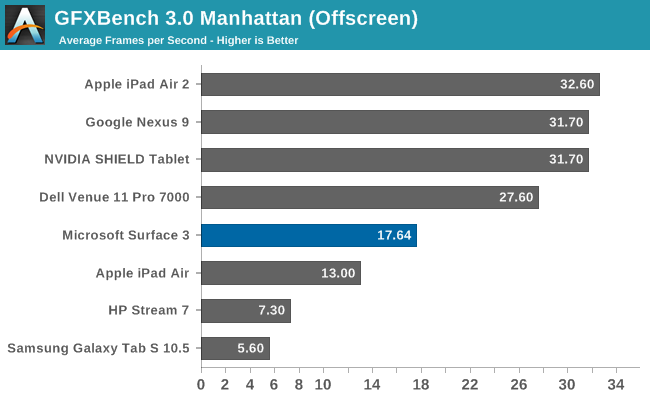
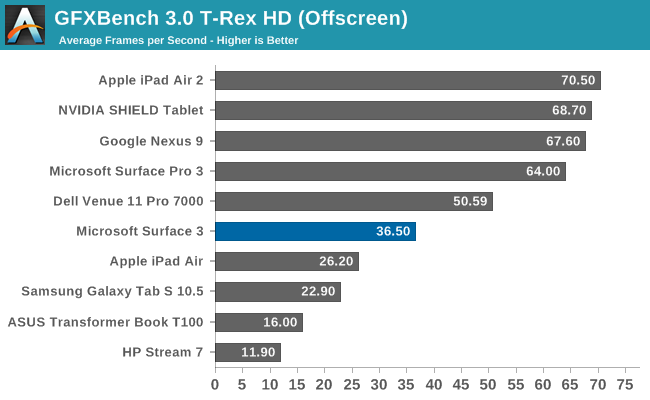
As with the 3DMark scores, the GPU upgrade is significant, but still a ways back of the best tablet GPUs out there. Intel still has some work to do on this front.
GFXBench Notebook (DirectX)
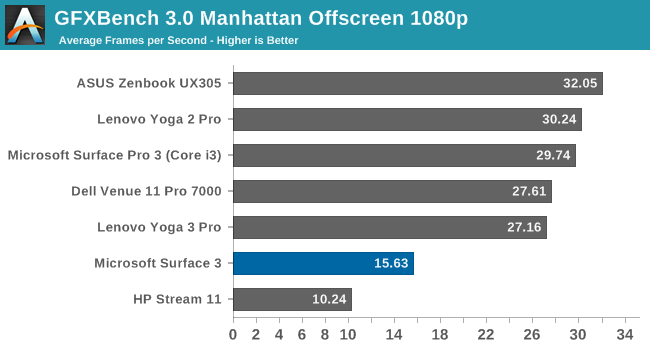
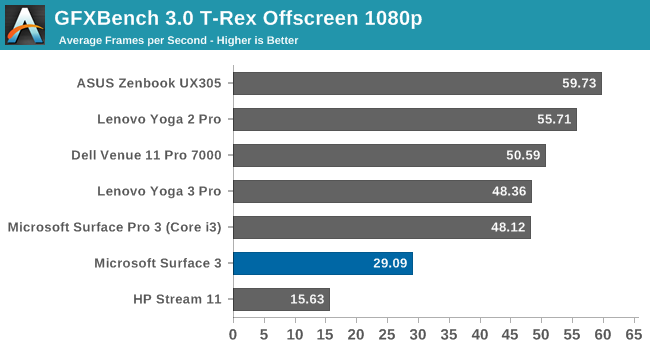
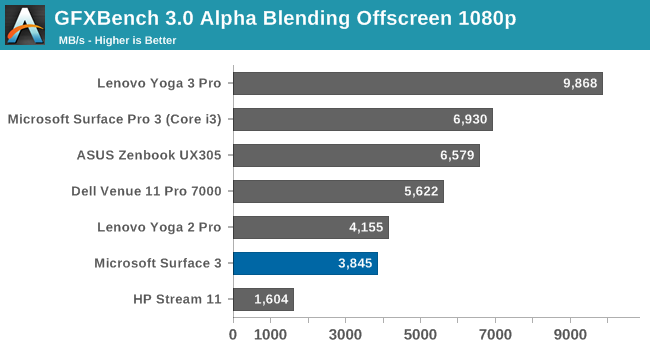

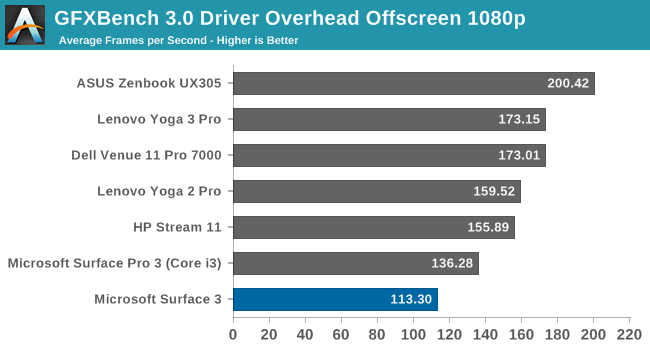
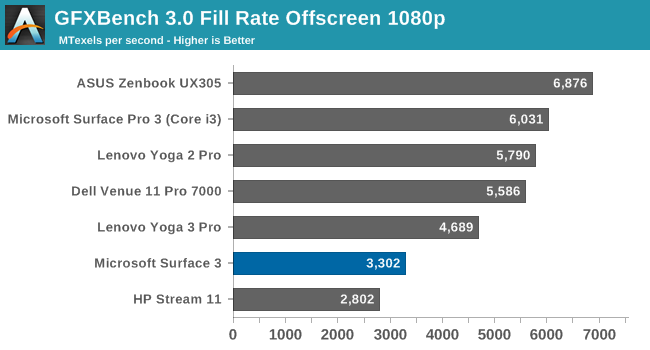

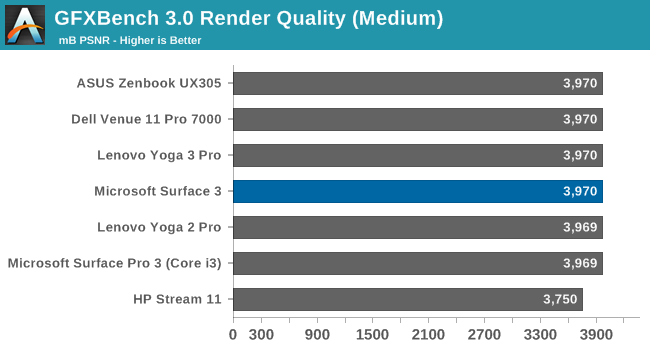
We see a similar story with GFXBench on the notebook side. The 16 EUs in our Atom SoC just cannot compete against the larger and faster GPUs in Core.
Moving on to a real-world game, we use a custom DOTA 2 benchmark for our lower powered devices. It is a very popular battle-arena game, and the GPU requirements are not too demanding.
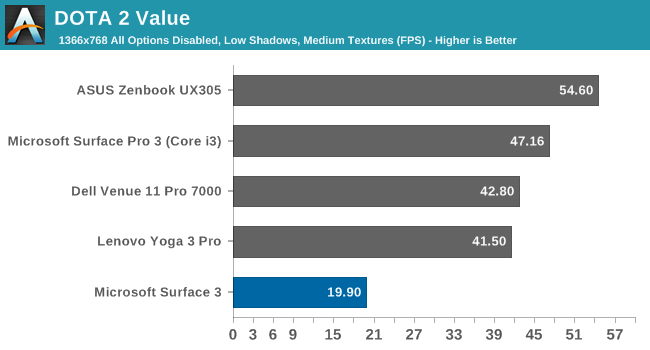
The GPU in the Surface 3 is really not enough to play most games, and even on our value settings, the Surface 3 is not a great experience for DOTA 2. The higher TDP of Core M lets it do ok in this test, but overall the Surface 3 is a long way back of even the Surface Pro 3 Core i3.
Storage Performance
Like most tablets, the Surface 3 utilizes eMMC storage rather than the SSD storage found on higher priced laptops and Core M tablets. It costs less, it is less complex, and it works. So expectations are that it will not be able to compete with the fastest solutions out there. But as a tablet, workloads should be less complex, at least in theory.
Unfortunately Microsoft shipped me the 64 GB version of the tablet, and due to PCMark 8 requiring a large amount of free space in order to perform its tests, it was unable to be run on this device. But we have run into this issue in the past, and we can turn to a couple of other tools to get a feel for how the storage performance is. Even though eMMC is slower than a good SSD, there is still different levels of performance based on the NAND in use and the controller.
I ran CrystalDiskMark over a 4 GB span and the results are below.
Surface 3 eMMC Storage (left) vs Surface Pro 3 Core i3 SSD (right)
Compared to a true SSD, the eMMC performance leaves a lot to be desired. In fact, most of the time when I was using the tablet and I found it slow, such as installing software, or loading programs, it was mostly disk bound. There are faster eMMC options available, but I will refrain from comparing it to other tablets since we do not have the same benchmarking tools for both.


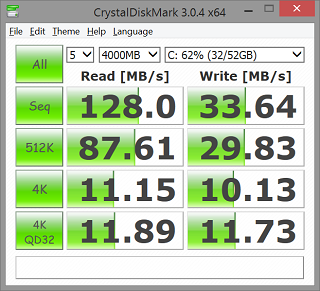
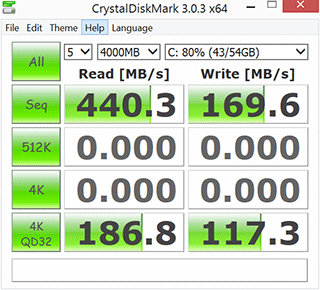








265 Comments
View All Comments
Luc K - Thursday, May 7, 2015 - link
Battery life of both Yoga 3 Pro and the Asus T300 Chi are not anywhere close to this one.Then again completely different kind of devices.
This Atom CherryTrail CPU is actually newer than Core M but different kind of line of CPU's obviously.
MattVincent - Tuesday, May 5, 2015 - link
The 64gb doesn't bother me but the 2gb of ram seems like its just cutting corners. Price goes up way to fast once you add on the accessories. They shouldn't be charging for the pen.TEAMSWITCHER - Tuesday, May 5, 2015 - link
Ya think? I just checked MacMall.com, and I can get a 2015 11" MacBook Air for $819. That includes an Intel Core i5 CPU with HD6000 graphics, a decent keyboard, industry leading trackpad, PCIe SSD, Thunderbolt port, 2 USB 3.0 ports, and MagSafe Power. The display on the Surface might be a little better, but the atom CPU and archaic storage are very more worse.I own an 2013 11" MacBook Air and have found it to be a very capable machine. The screen is small, but workable thanks to OS X's excellent full-screen app / virtual desktop implementation. When I'm in my office, I connect it to my 27" monitor, Apple Keyboard, & Magic Mouse and use it like any other desktop.
The Surface 3 possesses only one redeeming quality - a Pen. How bad are you willing to let Microsoft screw you over for a Pen? If the answer is "brutally" then buy a Surface 3.
xthetenth - Tuesday, May 5, 2015 - link
The screen isn't just small, it's wildly archaic with a low res and bad panel technology. I'd also love to see you try to use the air as a tablet. If you don't need a tablet, don't get a tablet, get an ultrabook.RafaelHerschel - Tuesday, May 5, 2015 - link
I considered a MacBook Air, but the screen was unacceptable at the price point. I'm sure that will be rectified in the future, but for now there are inexpensive Windows alternatives with much better screens.AnyOny24 - Wednesday, May 6, 2015 - link
If you want to talk about that price point you should talk about the Pro 3 core i5 which supports tablet mode / touch, the same pen you're talking about, bigger / better screen... silly comparison.damianrobertjones - Wednesday, May 6, 2015 - link
Or I can just buy the S3 along with a £20 BT keyboard.BlueBomberTurbo - Thursday, May 7, 2015 - link
Actually, the screen on the Surface 3 is the best portable screen you can get next to maybe the new Macbook. The Air's screen was terrible for anything requiring any level of color accuracy. You know, the artsy stuff that you can apparently only do on a Mac.The other redeeming qualities are its size and weight. I know I bought it specifically for those and the screen, as a portable workstation for my photography. When you cram lots of lenses and a couple camera bodies in your backpack, you're already hauling around a good amount of weight. A well-spec'd laptop certainly isn't going along for the ride, too.
lokhor - Tuesday, May 5, 2015 - link
Worst thing about the dock on the SP3 is that the angle cannot be adjusted so its virtually useless if you want to have it set up as a secondary screendigiguy - Tuesday, May 5, 2015 - link
Laughing out loud at the "bulky and heavy" comment. This tablet weights less than the ipad 4 and I was not hearing people call that bulky and heavy.... Better, this tablet has a whole inch more screen surface that the ipad.... But this is partly the fault of reviewers that call this a 10 inches device, like the ipad.... Why the ipad, that is 9.7 inches, is 10 inches and this one, at 10.8, is not 11 inches? Increase the screen size of the air and the weight will also go up, while still being a bit lighter, not to mention ipad 4 and below.I have a 600g 10.1 inches windows tablet and it feels very light and pleasant to hold with one hand, just awkward with its 16:9 ratio. The surface will feel more balanced.
Concerning storage speed, the 128GB model offers better performance (see this accurate review for more details http://www.notebookcheck.net/Microsoft-Surface-3-T...
Having said that, this is the performance with the encrypted SSD. Personally I decrypted the SDDs in all my tablets (Surface pro 3, HP Stream 8, etc.) and the performance, especially the sequential one, has significantly increased.